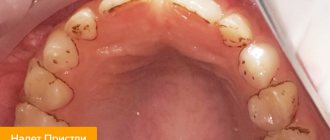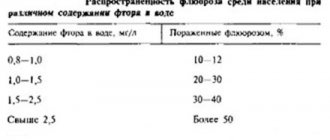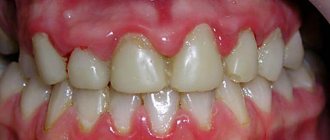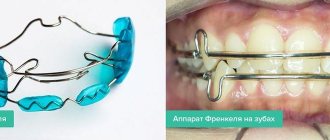Treatment of phlegmon
Treatment of phlegmon is surgical - opening the abscess, excision of necrotic tissue (see photo below).
In the photo, the phlegmon is opened, the Achilles tendon is visible at the bottom of the wound.
After opening the abscess, the wound is cleaned, inflammation subsides, and wound healing processes begin.
In the photo, the wound has cleared and is beginning to heal.
In the complex treatment of phlegmon, antibiotics, immunocorrectors, physiotherapy, etc. are also used.
The photo below shows phlegmon of the left forearm, which developed from a boil.
In the photo below, the same phlegmon is opened, the wound is cleaned.
The photo below shows the same wound, almost healed.
The wound has healed.
The photo below shows advanced phlegmon of the thigh. The duration of the disease is 2 weeks.
The patient refused hospitalization, so treatment of phlegmon had to be carried out in a clinic. In the photo below - the same phlegmon 7 days after the operation - the wound has cleared and is granulating.
After cleaning the wound, secondary sutures were applied (photo below).
Publications in the media
Postpartum infection is any infection of the birth canal in the postpartum period, accompanied by an increase in body temperature to 38 ° C or higher (at least during 2 of the first 10 days after birth, excluding the first 24 hours). Repeated vaginal examinations for rupture of membranes are the main cause of postpartum infections • Pelvic infections are most often caused by Staphylococcus pyogenes, b-hemolytic streptococci of groups A and D, anaerobic streptococci, some serotypes of Escherichia coli, and Clostridium perfringens type A after abortion. There are several stages in the development of PID •• The first stage - the infection is limited to the area of the birth wound: postpartum endometritis, postpartum ulcer •• The second stage - the infection spreads beyond the birth wound, but is localized: metritis, parametritis, limited thrombophlebitis (metrophlebitis, pelvic thrombophlebitis, thrombophlebitis of the lower limbs), adnexitis, pelvioperitonitis •• The third stage is further spread of infection: diffuse postpartum peritonitis, toxic shock, progressive thrombophlebitis •• The fourth stage is generalization of infection: sepsis without metastases, sepsis with metastases.
A postpartum ulcer is formed as a result of infection of wounds (cracks, tears) that occurred during childbirth on the perineum, in the vagina, on the cervix • The wound surface is covered with a dirty gray or gray-yellow coating, which is difficult to remove from the underlying tissue. The wound bleeds easily, the tissue around it is swollen and hyperemic. As a rule, the general condition is satisfactory; complaints of pain and burning in the vulva • The febrile stage lasts 4–5 days, the plaque is gradually rejected and the wound is cleaned. Epithelialization ends by 10–12 days • Treatment: bandage with hypertonic sodium chloride solution and antibiotics. If there are stitches, they must be removed.
Puerperal endometritis (“puerperal fever”) is the most common form of postpartum infection. First of all, the endometrium and adjacent myometrium are involved in the process • Clinical symptoms appear 3–4 days after birth: increased body temperature to 38–39 °C, tachycardia, chills. Local signs: subinvolution of the uterus, pain on palpation; lochia becomes cloudy, bloody-purulent, sometimes with a foul odor. Often there is a delay in discharge - lochiometer; The cervical canal can be filled with clots. The condition is accompanied by severe intoxication and painful secondary contractions. Duration of the disease - 8–10 days • Treatment: antibiotic therapy, desensitizing agents and vitamins.
Postpartum metritis develops simultaneously with endometritis or as a complication no earlier than 7 days after birth • The disease begins with chills and an increase in body temperature to 39–40 ° C. The uterus contracts poorly; during vaginal examination, the cervix misses a finger even 9 days after birth. The uterus is painful on palpation. The discharge is initially light, dark red mixed with a large amount of pus, often with an odor; then the lochia becomes serous-purulent. The duration of the disease is 3–4 weeks • Treatment is the same as for postpartum endometritis.
Postpartum parametritis is inflammation of the retroperitoneal fibro-fatty tissue of the pelvis.
• Pathways of pathogen spread •• Lymphogenous •• Hematogenous (with pelvic thrombophlebitis).
• Clinical picture •• The disease begins 10–12 days after birth with chills and an increase in body temperature up to 39 ° C, less often - up to 40 ° C. The postpartum woman complains of a dull nagging pain in the lower abdomen; with irritation of the peritoneum, the pain can be intense •• Local symptoms are mild at first: during vaginal examination, pastiness in the area of inflammation is determined. After 2–3 days, the infiltrate is clearly palpable, testy and then dense, moderately painful, motionless, usually located between the lateral surface of the uterus and the pelvic wall. The lateral vault of the vagina is flattened, the mucous membrane is motionless. With unilateral parametritis, the uterus shifts to the opposite side, with bilateral parametritis - upward and anteriorly •• The infiltrate may extend beyond the parametrium. When spreading anteriorly, it is palpated above the inguinal ligament; upon percussion of the anterosuperior iliac spines, muting is determined (Genter's symptom). When inflammation passes to the peri-vesical tissue, the infiltrate can spread along the posterior surface of the anterior abdominal wall to the navel (the abdominal wall gives the impression of a starched shirtfront). From the upper part of the parametrium, the infiltrate can spread to the kidneys.
• Fever lasts 1–2 weeks, the infiltrate gradually resolves. Relatively rarely, the infiltrate suppurates, the body temperature becomes remitting, and attacks of chills appear.
• Treatment: antibiotic therapy taking into account the sensitivity of the pathogen; in case of abscess formation, opening of the abscess is indicated.
Postpartum pelvioperitonitis is an inflammation of the peritoneum limited to the pelvic cavity. In the acute stage of the disease, a serous or serous-fibrinous effusion is formed; on the 3rd–4th day it becomes purulent. Fibrinous deposits fuse the omentum and intestinal loops with the pelvic organs, limiting the purulent focus • In contrast to diffuse acute postpartum peritonitis, with pelvioperitonitis local symptoms predominate. The onset of the disease resembles the clinical picture of diffuse peritonitis: it occurs acutely, accompanied by fever, chills, sharp pain in the lower abdomen, nausea, vomiting, bloating and abdominal tension; The Shchetkin-Blumberg symptom is positive. After 1–2 days, the general condition improves, abdominal bloating is limited to the lower half, and a transverse groove is identified on the anterior abdominal wall at the border between the inflamed and healthy parts of the abdominal cavity. During vaginal examination in the first days of the disease, only density and soreness of the posterior vaginal vault are noted; then an effusion appears behind the uterus, protruding the posterior fornix in the form of a dome and first having a doughy, then densely elastic consistency. Effusion moves the uterus anteriorly and upward. The disease lasts up to 1–2 months • Treatment - broad-spectrum antibiotics, infusion and desensitizing therapy. If the exudate suppurates, a colpotomy is performed.
Postpartum thrombophlebitis occurs as a result of the spread of postpartum infection through the veins of the pelvis. The condition of patients is usually satisfactory, body temperature is 37–38.5 °C, tachycardia. In the blood there is moderate leukocytosis, a shift in the leukocyte formula to the left, a slight increase in ESR. The inflamed vein is tense, painful on palpation, the skin over it is hyperemic • Metrothrombophlebitis occurs with tachycardia, subinvolution of the uterus, and prolonged heavy bleeding. Vaginal examination reveals characteristic tortuous cords on the surface of the uterus • Thrombophlebitis of the pelvic veins develops no earlier than the end of the 2nd week of the postpartum period. During a vaginal examination, a poorly contracted uterus is revealed; the affected veins are palpated at the base of the broad ligaments of the uterus and on the side wall of the pelvis in the form of painful, dense and tortuous cords. It is more difficult to identify lesions of the veins of the ovarian plexus. Vaginal examination reveals a small infiltrate resembling inflammatory changes in the appendages. With thrombophlebitis of the ovarian plexus, the likelihood of thrombosis and thromboembolism is high • Thrombophlebitis of the deep veins of the lower extremities most often develops in the 2-3rd week after birth •• The disease usually begins with the appearance of acute pain in the leg, chills and fever. After 1–2 days, swelling appears. Coldness of the leg and a crawling sensation are noted. •• With iliofemoral thrombophlebitis, dilatation of the saphenous veins occurs in the inguinal and iliac regions, on the anterior and lateral surfaces of the abdominal wall. Upon palpation, a painful infiltrate in the iliac region is determined; As a rule, pain is noted in the upper third of the thigh along the neurovascular bundle. When the external iliac and hypogastric veins are affected, swelling is observed in the lower abdomen and lower back, and often swelling of the labia. With thrombophlebitis of the femoral vein, the first symptoms are smoothing of the inguinal fold, pain on palpation of the femoral triangle, palpation of thickened vessels in the depths of it, dilatation of the saphenous veins on the thigh. Swelling of the lower leg and pain in the calf muscles are often noted. The duration of the disease is 4–6 weeks. Fever lasts from several days to 2-3 weeks • Treatment •• Bed rest with the affected limb elevated •• Bandaging the leg with an elastic bandage •• Broad-spectrum antibiotics •• Desensitizing agents •• Antispasmodics •• Heparin in combination with ethyl biscoumacetate or phenindione under the control of blood coagulation parameters •• In the initial stage of thrombophlebitis (the first 24 hours after the formation of a blood clot) - fibrinolysin and heparin intravenously •• After suffering thrombophlebitis, it is recommended to bandage the legs with an elastic bandage.
Progressive thrombophlebitis. The process is not limited to local inflammation of the venous wall and the formation of a blood clot, but spreads along the vein. When a blood clot breaks off, pulmonary embolism and pulmonary infarction occur • Clinical picture. With embolism of a branch of the pulmonary artery, a sharp reflex spasm of its other branches and bronchospasm develop; acute cardiovascular failure develops. With embolism of large branches of the pulmonary artery, severe weakness and pallor appear, blood pressure decreases, tachycardia and chest pain occur. Symptoms of small branch embolism include shortness of breath, pain when breathing, and tachycardia. With a pulmonary infarction, a characteristic clinical picture appears: pain during breathing, dullness of percussion sound, weakened breathing with a bronchial hue, fine moist rales at the periphery of the infarction, increased body temperature, leukocytosis • Treatment •• Immediate intravenous administration of morphine and antispasmodics •• Oxygen inhalation •• Fibrinolysin and heparin intravenously, then - heparin and indirect anticoagulants •• In case of embolism of the main trunks of the pulmonary artery, immediate surgical intervention is necessary.
Diffuse postpartum peritonitis more often (more than 90% of cases) occurs as a complication of cesarean section, less often it can be caused by exacerbation of inflammation of the uterine appendages or the development of septicopyemia. Risk factors: acute and chronic infectious diseases during pregnancy, long anhydrous interval (more than 12 hours), repeated vaginal examinations during childbirth, septic endometritis.
• Etiology. The most common pathogens are Escherichia coli and mixed gram-negative flora, less often - staphylococcus.
• Pathogenesis. During peritonitis, three phases are distinguished: •• First phase (initial, protection phase). In the abdominal cavity, exudate is formed, first of a serous-fibrinous, then fibrinous-purulent or purulent-hemorrhagic nature. Microcirculation disturbances occur: first, a spasm of the peritoneal vessels appears, then their expansion, blood overflow, and the development of congestion. Exudation of fluid into the abdominal cavity increases. The fibrin that has fallen out of the exudate prevents the absorption of fluid by the peritoneum, tightly adhering to the serous surfaces and gluing them together. Severe hypovolemia occurs. Loss of sodium and potassium ions is the cause of intestinal atony •• Second phase (toxic). Severe hemodynamic disturbances, microcirculation disturbances, kidney and liver function, progressive hypoxia and disturbances of all types of metabolism develop. Hemodynamic disturbances lead to a sharp dilation of the vessels of the abdominal cavity and the deposition of a significant volume of blood in them. Complete intestinal paresis develops. Continuous vomiting increases dehydration. As a result of increasing intoxication and microcirculation disorders, degenerative processes develop in parenchymal organs. Acidosis and tissue hypoxia progress •• The third phase (terminal) is accompanied by hypovolemic shock, septic shock, cardiac dysfunction, leading to the death of the patient.
• Clinical picture. Abdominal pain, nausea, vomiting, flatulence, progressive intestinal paresis, dry tongue. Tension of the muscles of the anterior abdominal wall and the Shchetkin-Blumberg symptom may not be expressed clearly enough. During auscultation, no sounds of intestinal peristalsis are heard (symptom of “deafening silence”). Percussion reveals free fluid in the abdominal cavity; the symptom of fluctuation is positive. Body temperature is high, less often subfebrile, pulse is increased, blood pressure is reduced.
• Surgical treatment in combination with intensive conservative therapy: antibiotics, detoxification agents (polyglucin, hemodez, etc.), correction of blood pressure and water-electrolyte balance.
Infectious-toxic shock is a serious condition resulting from toxemia. Arterial hypotension, oliguria, tachycardia, tachypnea, fever, and microcirculatory disorders develop due to diffuse damage to cells and tissues by toxins. The main lesions are associated with the action of endotoxin (a heat-stable lipopolysaccharide component of the cell wall of microorganisms). Less commonly, the cause is toxins of gram-positive bacteria, viruses and yeast-like fungi.
•• Etiotropic therapy ••• Antibiotics (it is preferable to prescribe bacteriostatic drugs, since the use of bactericidal drugs can cause deterioration of the patient’s condition due to an increase in endotoxemia) ••• Administration of antistaphylococcal plasma and -globulin (for staphylococcal infection) or fresh frozen plasma (for unidentified pathogen).
•• Pathogenetic therapy ••• Elimination of hypovolemia by introducing volume-replacing solutions ••• Improving microcirculation by introducing rheopolyglucin ••• To maintain vascular tone - dopamine ••• To relieve intoxication - hemodez ••• If necessary - diuretics ••• Opinions about the advisability of prescribing high doses of GCs is controversial (in domestic practice, the use of hormones during sepsis is recommended for all patients with shock) ••• Cardiac glycosides - according to indications ••• The possibility and prospects of passive immunotherapy (monoclonal antibodies against lipopolysaccharides) are currently being studied.
Sepsis is a life-threatening proliferation of bacteria in the vascular bed. There are sepsis without metastases (septicemia) and with metastases (septicopyemia).
• Septicemia is an acute systemic disease that occurs with bacteremia and severe intoxication. It often begins 2–3 days after birth. Clinical picture: fever, severe general condition, tachycardia, sallow or grayish-yellow skin; tongue dry, coated; the stomach is swollen. At the height of the disease, collapse may occur. A serious complication of sepsis is acute adrenal insufficiency.
• Septicopyemia with metastases is characterized by the formation of metastatic purulent foci in various organs, primarily in the lungs. The disease most often begins 10–17 days after birth. Clinical picture: fever of a remitting or intermittent nature, chills, profuse sweat, rapid pulse of weak filling, pale skin, dry tongue, moderate leukocytosis in the blood and a significant shift of the leukocyte formula to the left, a sharp increase in ESR, progressive anemia, jaundice, hepatosplenomegaly, bacteriuria, proteinuria, cylindruria.
• Treatment •• Antibacterial and detoxification therapy •• If empyema of the lungs or pleura, abscess of the kidney or liver, purulent meningitis, septic endocarditis occurs, specialized care is required •• In case of sepsis, it is especially important to identify the pathogen and prescribe treatment taking into account the sensitivity of the microorganism to antibiotics. The administration of drugs begins before the results of the study are received.
Anaerobic infection , as a rule, is a consequence of criminal abortion. The most common pathogen is Clostridium perfringens, which multiplies in necrotic tissues. Necrosis spreads quickly, soft tissue disintegrates with the formation of gas. Severe intoxication occurs due to toxemia, which represents the greatest danger. The process can be localized (limited to a small area of the uterus). With gangrene of the uterus, spreading to the serous layer, a serous-hemorrhagic effusion forms in the peritoneal cavity.
• Clinical picture. The disease develops quickly, the general condition worsens, shortness of breath, cyanosis, and anxiety increase. The triad is characteristic: jaundice with a bronze tint, hemoglobinemia and hemoglobinuria. Nephritis develops with the formation of hyaline casts and anuria. The initial stage of the disease occurs with severe intoxication; at this stage, death from septic shock is possible. The second stage is accompanied by acute renal failure. Death can occur not only in the oliguric phase, but also in the polyuric phase from acidosis. The duration of the disease is from 1–2 days to several weeks.
• Treatment •• Surgical intervention - curettage (aspiration) or abdominal hysterectomy •• Use of antibiotics in large doses •• Administration of serum with a high titer of specific antibodies •• Exchange blood transfusion •• Oxygen therapy.
ICD-10 • O85 Puerperal sepsis • O86 Other puerperal infections
Urinary tract infections occur frequently during the postpartum period.
• Causes •• Bladder injury during vaginal delivery •• Hypotension of the bladder, especially with conduction anesthesia •• Catheterization.
• Treatment •• Antibiotics - taking into account the sensitivity of the pathogen. If it is impossible to identify the microorganism, broad-spectrum antibiotics are used •• Nitrofuran derivatives (furazolidone, nitrofurantoin), sulfonamides •• Herbal preparations (infusion of bearberry leaves) •• Diuretics.
ICD-10 • O86 Other postpartum infections
Abscess
Unlike phlegmon, an abscess is an accumulation of pus separated from other tissues. In essence, an abscess is a localized phlegmon.
In the photo - in the upper outer quadrant of the left gluteal region - there is a painful swelling with redness of the skin. 10 days ago, injections were given in this place - post-injection abscess of the left gluteal region.
In the photo above, against the background of existing callus, pain, redness of the skin, swelling arose, the epidermis was partially exfoliated with pus - a subcallosal abscess.
Causes of occurrence in adults, children and characteristic symptoms
Children and adults, regardless of gender, are susceptible to pathology. More often, an abscess is diagnosed in a child with weak immunity. Purulent inflammation of the eyelid is caused by the active proliferation of pathogenic bacteria - staphylococci, streptococci.
Factors that provoke inflammation near the eyes:
- blood-sucking insect bites;
- squeezing out acne and poor eyelid skin care;
- a foreign object caught in the eye;
- purulent inflammation affecting the sinuses or located in the oral cavity;
- improper treatment of acne, styes, boils;
- meibomite.
Routes of infection that result in eyelid abscess:
- penetration of pathogenic microorganisms through damaged skin folds in the eye area - wounds, scratches, cuts;
- spread of infection, the focus of which is in the orbital area - barley, squeezed pimple near the organ of vision;
- infection transferred through the bloodstream from its other foci - otitis, sinusitis, stomatitis, tonsillitis.
Often, the appearance of inflammation on the eyelids is caused by improper treatment of purulent formations near the eyes. Independent removal of blackheads and other formations with this localization carries the risk of consequences.
The symptoms of the pathology gradually worsen. The accumulation of purulent contents of the cavity leads to greater severity of symptoms.
The development of symptoms is not rapid, as with barley. Signs of a purulent abscess are steadily increasing, acquiring a pronounced character. The pathology causes the patient a lot of discomfort.
Abscess symptoms:
- The tissues in the orbital area thicken and become denser.
- The eye begins to swell due to swelling of the eyelid. Redness of the skin of the mobile fold. When you press your fingers on the problem area, the painful pulsation intensifies, indicating a purulent-inflammatory process. Feeling hot is evidence of a local increase in temperature.
- Vision deteriorates.
- With an abscess that has formed on the upper mobile fold of the skin, it is difficult to close the eye. The eyelid may become very swollen, making it difficult for the eyeball to close.
- With a large area of damage, symptoms of general intoxication occur in the form of fever, weakness, and elevated temperature (the indicator can reach +39.8 ⁰C).
- Feeling worse, headache.
- The appearance of a white or yellowish speck at the site of compaction is evidence of purulent contents. After a few days, the abscess will open and the pus will come out.
The release of contents from the cavity formed on the eyelid helps to alleviate the condition and eliminate unpleasant symptoms. If the pus is not completely cleared, the symptoms return and the inflammation becomes chronic. Fistula formation is observed.
Opening the tumor on your own is prohibited - there is a risk of spreading the infection.
An abscess, regardless of type, requires urgent treatment.
Atheroma
A type of abscess - suppurating atheroma - video of an operation to open an abscess
At the stage of abscess formation, there is still the possibility of conservative treatment (antibiotics, physiotherapy, semi-alcohol dressings), which often results in cure. If a cavity with pus has formed, the only treatment is surgery. Under anesthesia or local anesthesia, the abscess is opened, pus flows out, after which the dead tissue is excised as completely as possible, the wound is washed and drained. After the operation, dressings are required (daily or every other day). The wound healing period is 10 - 20 days (depending on the size, depth and other factors. With extensive phlegmon, skin grafting may be required.










